5 Virtual Teaching Strategies We’re Using
A MiddleWeb Blog
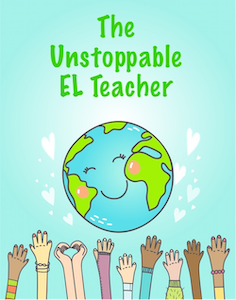
Due to the increase of schools and districts offering distance learning or virtual school in response to the COVID19 outbreak, I wanted to share how my school in Saigon is structuring online learning for students.
This is not an article directly related to working with language learners, but the suggestions can be applied to working with language learners.
There are numerous ways to structure online learning, and I would like to share how we have structured it within our international, independent school context. Readers of this article will find it helpful if they are also offering a one-to-one program. These structures work for us because all of our students have internet access at home.
Here in Vietnam, we have been offering virtual school since February 3rd, and we did not have time to prepare students or families on how to navigate virtual learning. We are entering our 7th week of virtual learning, and these structures have been the ones that have been the most successful for us.
Use the same foundational blocks
The key is to build a virtual school on the same blocks that form the foundation of your in-person school. The how of virtual school will look different than in-person school, but the why must remain the same. For us, that means:
• prioritizing curriculum planning
• investing in relationships with students, colleagues, and families
• intentionally integrating technology when appropriate
You will see these three foundational blocks in the five structures I share in this article.
Create a Week-at-a-Glance document
I suggest creating a document that houses all the work students are supposed to do for the entire week. We did not do this initially as we thought virtual schooling was going to be just a two-week experience.
As a result, students, teachers, and families were soon drowning in the flood of links and documents.
We then created a Week-at-a-Glance document to house all of the assignments for the week. Where applicable, we embedded links to videos, assignments, and other documents. Both students and families appreciated this document as it provided a big picture of the week. Students and families could design their day and week by anchoring to this document.
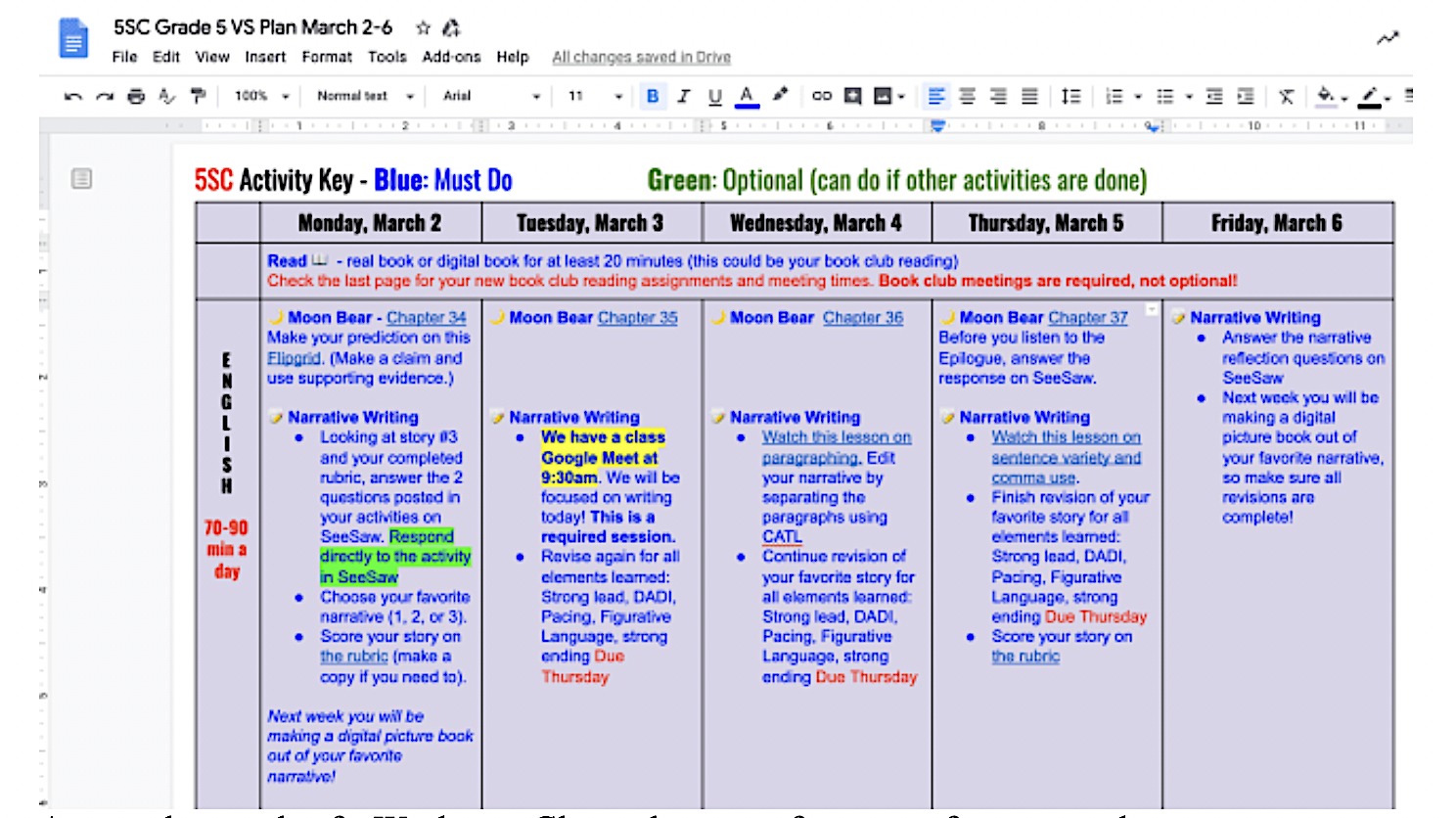
An actual example of a Week-at-a-Glance document from one of my co-teachers. Here’s a template. Click to enlarge.
Host office hours
In my grade we have blocked off 9 AM to 11 AM as teacher office hours. We scheduled our online conferences with students with Google Meet. The teachers in my grade used this time to:
- Model instruction
- Teach content
- Gauge student wellness
- Host book clubs
- Provide small group or individual tutoring
Because the teacher office hours are at a consistent time, students became used to this time and families appreciated that it structured the day for students. They could plan for activities with their children after 11 AM.
I encourage you to have small-group meetings of five to eight students for 20 to 30 minutes. Larger groups mean less engagement by students. Just like how they hide from participating during in-person school, a whole-class virtual meeting provides an enticing opportunity to disappear. The short duration keeps the meetings engaging.
Most of the time, these meetings are scheduled and assigned. At other times, we give students a time frame for individual conferncing, and they can self-select available appointment times.
The key to virtual learning is not losing the personal element of an in-person classroom. With frequent and weekly online conferences, students retain some semblance of a learning community that makes school so special.
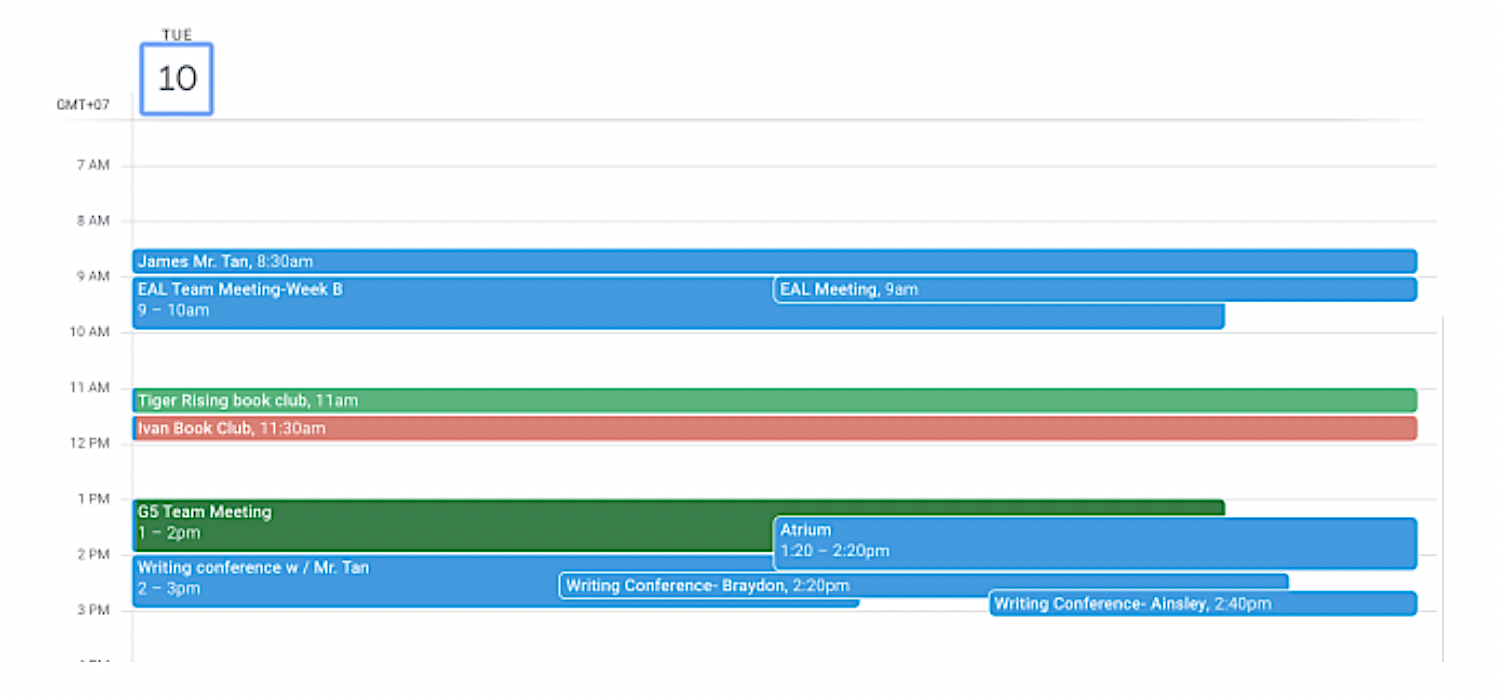
One day of virtual school for Tan that includes times with students and team members. Click to enlarge.
Collaborate with colleagues
No other time in my teaching career has collaborating with colleagues been so essential to students, families, and our collective well-being. We have made it a point to block 1 PM to 2 PM on Tuesdays and Thursdays to collaborate. We use this time to divide the work, share strategies, and support each other. One of the key deliverables from these meetings is a completed Week-at-a-Glance document for the following week.
At these meetings the language specialist can provide strategies that would work for language learners or team with another colleague to make virtual learning more accessible for language learners.
For the past six weeks our faculty has been coming to school and maintaining regular school working hours. As of March 17, we have been directed to facilitate the virtual learning system off-site. We will continue to collaborate but now virtually on Zoom. As we go to virtual teacher collaboration, the Week-at-a-Glance document will structure our online collaboration.
Leverage Technology
We could not offer instruction without technology as it has provided the means to teach content and facilitate student engagement. These are my most used programs to facilitate virtual learning:
Screencastify: Create a slide deck or a document used to teach a lesson. Record yourself narrating the slides or document. Send the video to students.
Edpuzzle: Embed comprehension questions or audio notes in a video recording. As students watch the video, the embedded question or audio note will appear and either play your message or ask them to answer a question. On the dashboard, you can check students’ responses if you have embedded a question.
Google Suite: We are using many of the products such as Google Docs, Slides, and Google Drawing to demonstrate their understanding and for us to share content.
Non-Google Suite creation apps:
Book Creator – users can publish their writing electronically
Flipgrid – users can record video responses
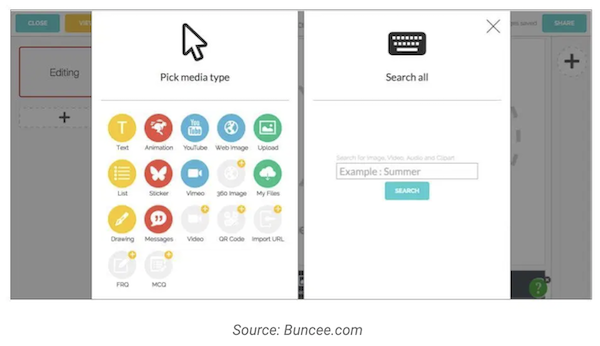
Adobe Spark – users can create animated videos, graphics, and web pages
Because I work in Vietnam, we cannot use Talking Points, but if I was in the U.S. or Canada and my school moved to distance learning, I would then use Talking Points to communicate with families. Talking Points allows teachers to
• Send free SMS messages to families in English.
• Families receive these messages in their home language.
• Families respond to the teacher by texting in their home language.
• The teacher receives the translated SMS message in English.
The program now allows you to communicate in 100+ languages! THAT’S AMAZING!
Send physical work home
Every two weeks, we send physical packets of work home. Families come to school and pick up the packets for their children. This might be an option for schools where teachers are still allowed to come to school to work. Additionally, this method might help families who do not have internet access at home. The contents of the packet can also align with the assignments on the Week-at-a-Glance document.
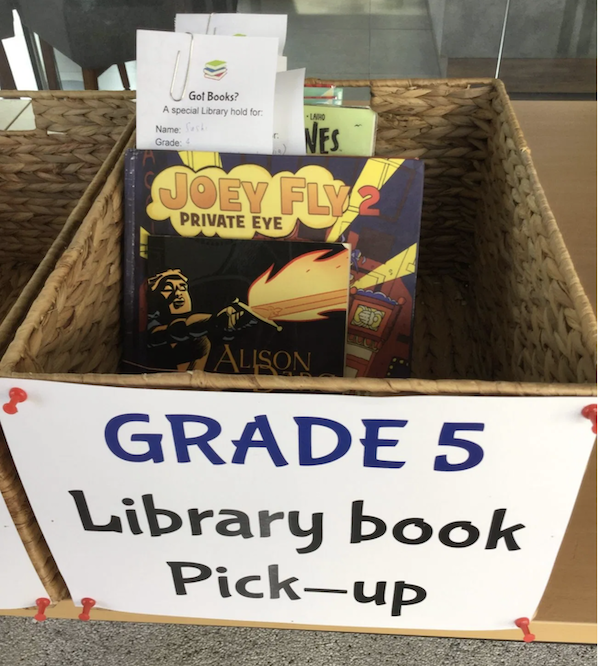
My school organizes library book pick-up to keep students engaged in reading.
We are creating the plane as we’re flying, but I hope the lessons we have gleaned from our seven weeks of virtual learning can be of service to you and your district. If you have questions, suggestions or ideas, please share them in the Comments or contact me on Twitter @TanELLClassroom.
May you, your personal family, and your school family stay safe and healthy in these demanding times. You’re not alone! I’m right there with you!

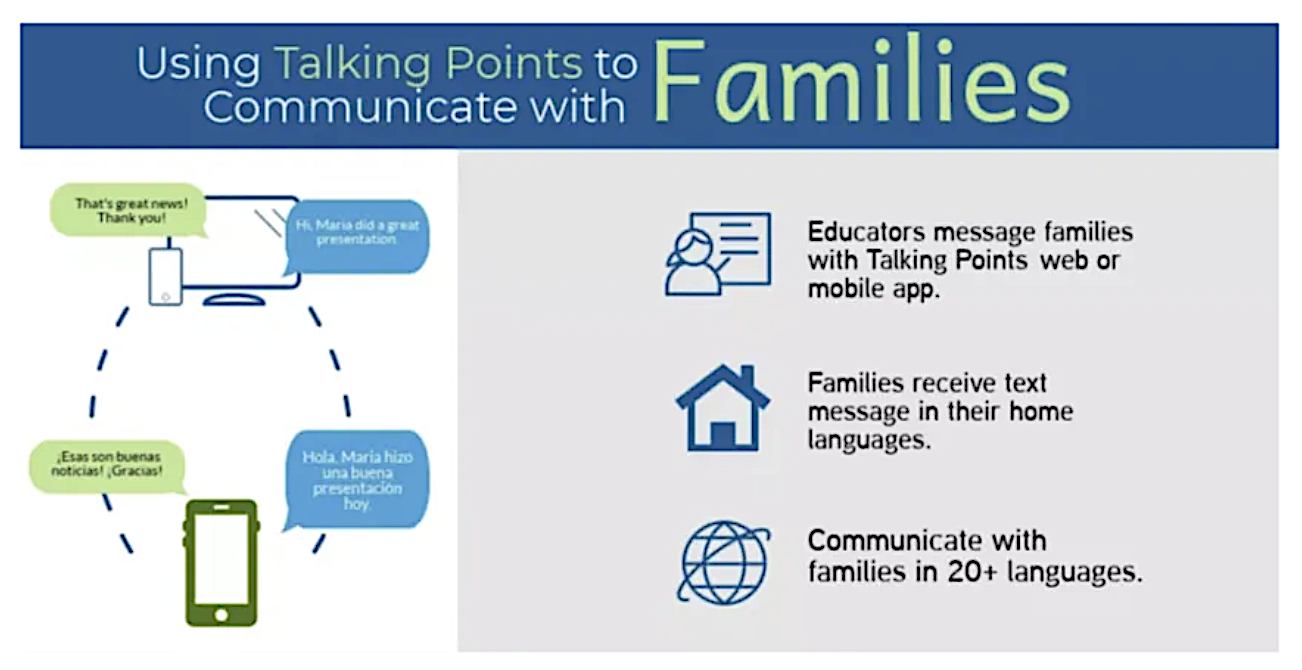

































Thank you so much for taking the time to share all of this information, and links. In Guatemala, we are just starting our distance learning due to Covid19, and many teachers are struggling with virtual teaching because they haven’t done this before. I am going to spread this, because this is gold. Thanks again, we appreciate it.
I’m honored that you found it helpful! Wishing you, your family, school, and students a health and peace.
Great work, CONGRATULATIONS….
Continue to share the good practices.
Thank you so much for sharing this wonderful information! I just moved from Florida to Maryland and was struggling to figure out how to learn the new curriculum and figure out how to implement it online as well. Your article and information has helped tremendously! Thank you again!
So happy that this could be of help, Michele. Stay safe out there!!!!
Wonderful suggestions, as South Africa embarks on the same! Thanks!
Stay safe, Robyn! This too shall pass!
Great info sharing! Thank you!
Thank you so much! In California, trying to figure out Special Ed services and how to deliver. This is so helpful. Stay well!
Thank you Tan – we have switched to online learning in our Australian school so advice like yours is so helpful as we embark on this very new and somewhat scary future.
Thank you, Kim! Sending prayers to your students in Australia! Stay safe!!!!
Super useful as I’m in the planning stages for a digital launch of my Spanish classes. Thank you for everything.
Hi, Eric. Yes. This can work for Spanish classes as well! Suerte, hombre!
Thanks Tan for trying to motivate other teachers. Now in the last weeks since we are on shut down my academy and I are engaged in starting classes for our students on Google classroom. Our biggest challenge is how to have contact with our students and give them meaningful work to do. My personal problem is lack of knowledge of new technologies.
Thanks
Yeah. It can be overwhelming, Letitia. Be gentle and forgiving with yourself. Your kids and their families understand that these are uncharted waters. Just take one action at a time and make sure to make kids feel cared for and things will be ok. That is the most meaningful thing we can do – make them know that you still care about them.
Thank you for sharing your plan. We are just beginning to deliver instruction online next Monday and can see where it could be overwhelming for us as well as our kids. Stay safe everyone.
Hi, Michelle.
I hope you have an easy transition. Take it one day at a time, one situation at a time. It will be ok!
Hi. This was really helpful. What do you use to create the Week at a Glance calendar?
Hi, Allison.
I just use Google Doc and then link documents and assignments into it. Families and students seem to really like it.
Thank you, Tan! this was very helpful. I’m sure your students appreciate how you are providing consistency in these challenging times. Great ideas here!
Thank you, Wendy. Yes! Consistency for students is what we need, and it helps create a routine for us.
Stay safe, Wendy!!!!!
Thank you so much, this is a wonderful support to us here in Ireland. Take care
Thank you, Niamh. Wishing you all the best as your schools go online!
Thank you so much for sharing your planning and resources! I will absolutely be using these in my team planning for our upcoming “distance learning”
lessons for 3rd grade.
Thank you, Shanti.
My best wishes to you, your team, and your third graders. We’ll get through this!!!
This is wonderful!
Many thanks Tan. May God bless you.
Do you have a blank template copy of your Weeks at a Glance document that is family-facing? I’d love to use it!
Hi, Mark.
I sure do: https://docs.google.com/document/d/11qkjAsohX6J9ECnRsXQlAvTjAnTWUcTdwXBQTx7qWsU/copy
Wishing you and your family healthy and peaceful days!
This was great technology information.
Thank you for the kind words, Jeannie. There’s so much we can do with technology to support and engage our students. Stay healthy!
Thank you for sharing!